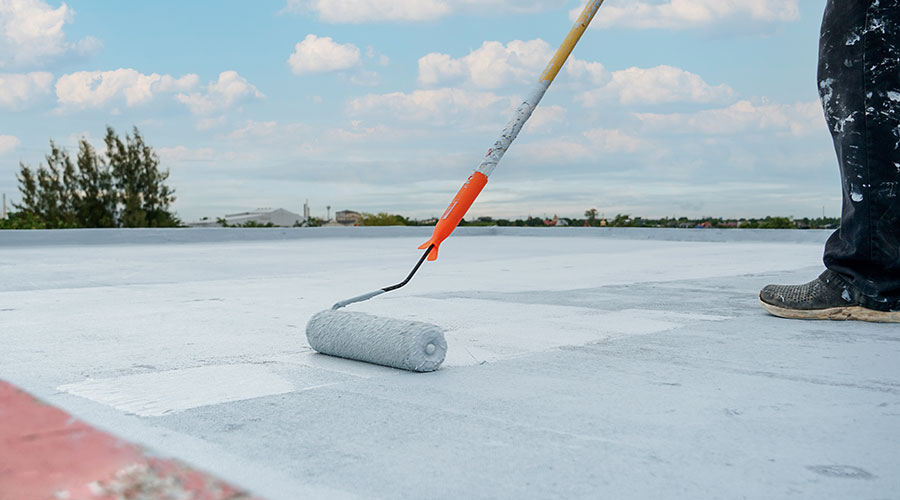Roofing and Fall Protection: Key Safety Considerations
Streamlining and improving facilities' roof safety programs can help managers protect the health and safety of front-line technicians.
By Kristen Panella, Contributing Writer
Roofs are an essential part of institutional and commercial facilities, and they require regular maintenance to ensure their durability and longevity. But working on a roof can be hazardous for front-line technicians, with falls from heights being one of the leading causes of workplace fatalities.
Unfortunately, many maintenance and engineering managers neglect to identify this hazard, or they simply ignore it. So it is crucial for managers to take steps to improve the safety of workers on roofs by implementing effective and compliant fall-protection measures. A closer look at key considerations in streamlining and improving facilities' roof safety can help managers protect the health and safety of front-line technicians.
Conduct a risk assessment
The first step in improving roof safety is to conduct a comprehensive risk assessment. Managers conducting a hazard assessment or developing a comprehensive fall protection plan need to think about fall hazards before the work begins. This approach will help the employer manage fall hazards and focus attention on prevention efforts.
This process involves identifying potential hazards, assessing the likelihood of accidents and determining the severity of the identified risks. A comprehensive risk assessment should include the following:
- identifying the roof's design, including the slope, height and access points
- determining the type of work that will be performed on the roof and the equipment that technicians will require
- identifying potential hazards involved in the work, including those related to skylights, unprotected edges and roof penetrations
- assessing the likelihood of accidents based on the level of traffic on the roof, weather conditions and the workers' experience
- determining the severity of the identified risks, based on the height of the fall and the potential for injury.
Using the results of the risk assessment, managers then can develop a comprehensive fall-protection plan that is tailored to the specific needs of their facility.
Choosing fall-protection equipment
Once a manager has completed a risk assessment for rooftop work by technicians, the next step is to determine the type of fall-protection equipment required for the job. The most common types of fall-protection equipment include:
- Guardrails. These permanent barriers are installed around the perimeter of the roof to prevent falls.
- Personal fall arrest systems (PFAS). These systems consist of an anchorage point, a body harness and a lanyard or lifeline. Workers attach themselves to the anchorage point, and the PFAS stops them from falling in the event of a slip or trip.
- Safety nets. These nets are installed beneath the roof to catch workers should they fall.
- Warning lines. These lines are placed around the perimeter of the roof to warn workers of the edge.
Choosing fall-protection equipment depends on the specific hazards identified during the risk assessment. For example, guardrails might be the most suitable option for roofs with unprotected edges, while PFAS might be better for roofs with multiple access points. If PFAS are used, technicians should pay particular attention to identifying attachment points, and managers need to ensure employees know how to properly use and inspect the equipment.
When assessing and choosing fall-protection equipment, creativity is key. For example, if managers plan on using warning lines, then maybe the policy is for technicians to use PFAS when outside the warning line.
Alternately, PFAS actually can increase the chance for a fall hazard in some cases. One example is when several workers on the roof using PFAS. The presence of so many life lines can create a tripping hazard. Employers who can demonstrate that it is infeasible or creates a greater hazard to use conventional fall-protection systems must develop and follow comprehensive written alternative to conventional fall-protection plans.
Provide adequate training and supervision
Fall-protection equipment alone is not enough to ensure the safety of workers on roofs. Proper training and supervision are also essential measures. Managers must ensure that all workers are trained in the correct use of fall-protection equipment, including how to inspect it before use and how to use it correctly. Workers also must be trained in emergency procedures, such as how to rescue someone who has fallen and how to administer first aid.
In addition to training, supervisors must ensure that workers use fall-protection equipment correctly and that they follow all safety procedures. Regular inspections of equipment and worksites should be conducted to identify potential hazards and to ensure that workers follow safety protocols. The Occupational Safety and Health Administration (OSHA) website offers a wealth of safety information pertaining to fall protection.
Comply with applicable regulations
Finally, it is essential for managers to ensure that their fall-protection program is compliant with all relevant regulations and standards. In the United States, OSHA sets standards for fall protection in the construction industry. OSHA requires that workers on roofs over six feet high be protected from falls.
But managers also might need to follow the standards for mobile elevating work platforms, personal protection equipment and other equipment to complete the task. Standards also exist for specific industries, such as telecommunications and electric power generation, that managers might need to review.
The ANSI/ASSP Z359 fall-protection and fall-restraint standards address fall-protection equipment and systems for climbing, work positioning, fall arrest, rescue, evacuation and other fall hazards. These standards also address training and ways to identify and abate hazards to prevent injuries for technicians working at height. Compliance with these regulations is critical because noncompliance can result in hefty fines and legal liability.
Roofing and fall protection are critical considerations for maintenance and engineering managers planning and overseeing roofing projects on their facilities. By conducting a thorough risk assessment, choosing the right fall protection equipment, providing proper training and supervision and ensuring compliance with all relevant regulations and standards, they can develop and implement a roofing and fall-protection program that not only fulfills regulatory requirements but actually increase technician knowledge base and prevents accidents.
Kristen Panella is the founder of 2SAFE Consulting Inc. He is 2SAFE’s principal trainer in EPA and OSHA regulations and is an OSHA authorized trainer. He has completed numerous training classes in OSHA safety and hazardous waste operations and emergency response.
Related Topics:












